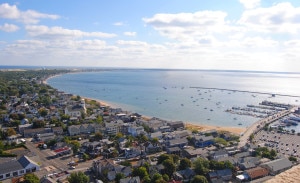Cape Cod has long been a tourist destination. Even so, there was always a sizable year-round population of regular folks – some newcomers drawn by booming restaurants and hotels, others with roots stretching all the way back to the Pilgrims.
But the Cape now finds itself in danger of becoming not just an exclusive resort for the wealthy, but one that can’t even be bothered to make any provision for housing the help that does all the work, from cooking the meals to staffing the stores.
More and more buyers are snapping up second homes on the sandy spit, stoking a dire affordability problem for the people who keep the Cape’s tourist economy humming, from restaurant workers and store clerks to hard hats.
That’s the finding of a new report on the Cape housing market by a group of top housing consultants, which warns that Barnstable County’s affordability problem is poised to only get worse as the second home tide rolls on.
“The Cape is experiencing a long-term surge in seasonal unit demand that it has never experience before,” notes the report, recently released by the Cape Cod Commission.
Half of all the second homes in Massachusetts are now on the Cape. And what little homebuilding is happening is mostly second homes, with the exception of a few, modestly-sized affordable rental projects in the works.
Demand for vacation homes is expected to grow by 6 percent over the next eight years, or twice as fast as that for year-round homes, the report notes.
The low wages in many of the Cape’s mainstay tourism businesses have combined with rising home prices to create a huge and growing “affordability gap.”
The median price of a home in Barnstable County, which covers the Cape, is $370,000 year to date through August, within striking range of pre-recession 2007, when it topped $380,000, according to The Warren Group, publisher of Banker & Tradesman. Over the last two years, prices have jumped more than $24,000 and, more importantly, are outstripping wages, which are barely keeping up with inflation, if that.
There is currently a shortage of 26,364 homes that are affordable to Cape residents making 80 percent of Barnstable County’s median household income of $63,251. That gap is expected to swell to 33,597 by 2025, according to the Cape Cod Commission’s report.
Add the lack of affordable apartments to the mix, and the housing gap more than doubles by 2025, to a shortage of over 45,000 reasonably priced homes and rentals on the Cape.
By then, though, the housing crunch will have spread to an even broader swath of Cape families, from the working-class families who are already struggling to their middle-class peers.
Families making up to roughly $80,000 will start to feel the shortage. On paper there are enough homes in $230,000 to $400,000 price range to meet demand for middle-income buyers, though it is a figure skewed by the fact that many of these homes are now occupied by seniors who want to downsize but have nowhere to go on the Cape, the report notes.
The paper surplus will be gone by 2025, with a gap between supply and demand in this price range of more than 18,000 homes.
Deserted Streets In Provincetown
 However, this increasing shift towards second homes is not only driving up prices beyond the means of most year-round Cape Codders, it is also turning this classic stretch of New England coastline into a shallow vacation destination in the service of the wealthy.
However, this increasing shift towards second homes is not only driving up prices beyond the means of most year-round Cape Codders, it is also turning this classic stretch of New England coastline into a shallow vacation destination in the service of the wealthy.
In fact, a vicious cycle is already well underway in which the construction of vacation homes and conversion of year-round homes into seasonal rentals begets more of the same, the report notes.
“As the number of second home owners increases, the seasonal economy becomes stronger, more businesses close in the off season, which further increases seasonal migration, decreases municipal tax revenue from year-round residents, and increases the town’s incentive to attract more seasonal homeowners,” the commission’s report notes.
If you want to see what the future may hold for the Cape, take a look at Provincetown, which is ground zero for this trend. The town has long prided itself on being more than just a tourist destination with its mix of artists, writers and creative types with salt-of-the-earth fishermen. But as demand for second homes has surged, developers have swooped in, converting motels and homes into condos, seasonal rentals and more expensive vacation getaways.
After topping $1 million last year, the median price in Provincetown is back down to $945,000, though still way above its 2007 price of $772,000, according to The Warren Group’s stats.
Provincetown’s year-round population has dwindled and is now under 3,000 – compared to the more than 60,000 people who jam the streets and restaurants during the summer.
The number of restaurants and other establishments open year-round has declined, and the high school closed years ago. The number of students in the lower grades is also dropping off steadily, while teachers can’t find a place to live in town – even if they could afford it.
Second homeowners and investors own more than 70 percent of the housing in town, The New York Times noted in 2015. That makes for a lot of empty homes and quiet streets during the long, dark months that make of most of a New England year.
If the Cape is in danger of becoming a giant beach resort, then Provincetown offers a glimpse of a Potemkin future, one where everything is for show for a few short months and practically deserted the rest of the time.
For Cape communities with proud histories stretching back hundreds of years, that’s a sad vision to contemplate.




 |
| 





